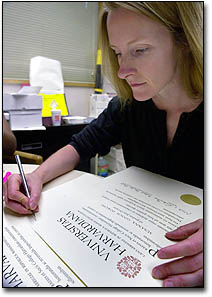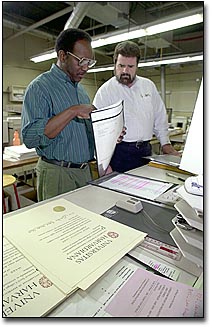Printers get ready by degrees
It is 11 on a balmy spring night. Kathy Pendrak and Brenda Waldron, prepress operators at Harvard Printing and Publications Services (HPPS), sit at computer terminals massaging mountains of data. Prepress Manager Stephen Grayman toils in the same manner, so that student names, degrees, schools, and honors will print error-free on one of HPPS enormous printers the following morning.

Early in the morning, while Pendrak and her colleagues continue to work on a new batch of commencement data, Frank Lynch, an HPPS printer for the past 30 years, takes up his post at a 135-page-per-minute Xerox Docutech printer. He has just sent the highly coveted and carefully protected commencement data to this printer from a computer perched just inside the enormous print room. Lynch loads the paper tray with the diploma “bases,” pre-printed templates custom-made at HPPS for the various types of Harvard diplomas. He presses a few buttons at the printers console and, moments later, witnesses the emergence of the first of Harvards 6,500 diplomas as they pop out of the huge machine, complete with college seal and appropriate signatures.
“During diploma season, which runs from the end of May and goes into June, the lights dont go out around here,” says Grayman. “We pretty much camp ourselves here until all of the schools data is checked and formatted.”
The folks at HPPS arent the only ones who ratchet up their work schedule to accommodate commencement. Anita Pariseau, director of the Class Report Office at the Harvard Alumni Association, receives the graduation data from most of the frenetically moving schools by the third week of May. She sends it over to HPPS after making changes to match the commencement program style sheet.
Pariseau also stays on top of changes to the data as these flow in from the various schools she deals with (which include all but the Arts & Sciences at the graduate and undergraduate levels). “Through me,” she says, “HPPS receives a final degree list for 4,500 of the Universitys total of 6,500 diplomas. The registrars changes come to me up to three days before commencement, and I make sure that all of these changes are incorporated into the list that Ive given HPPS.”
As arduous as this process may sound, the printing of diplomas used to take a lot longer and be spread over a much more drawn-out length of time. Recalls Lynch, “we used to be working on diplomas in an ongoing way, and every time there was a change, we had to go back and print a whole new diploma.”
The big improvement has been the integration of computer technologies particularly networks of computers that can talk to each other into the diploma production process. Grayman and his colleagues, for instance, transmit their massaged data to Lynchs pressroom computer. Lynch, in turn, seamlessly conveys the data to his printer. It is the use of the computer that allows the individual schools to send in their commencement data at the end of the process, rather than communicating it time and time again as their information evolves over the course of the academic year.
It is perhaps no surprise that modern technologies should influence how printing is done at Harvard, as it has everywhere else. But Harvard, with its venerable tradition of maintaining the longest continually operating printing press in the United States, has paid strict attention to integrating technology even while maintaining time-honored practices and codes.
The diplomas, for instance, are printed on a highly durable grade of paper that, according to Frank Urso, HPPS and of University Information Systems Technology Services, has been in use for many years. “We still retain the skills and we still value those things about printing that make it a craft,” Urso says.
Another time-honored tradition that has been refined by the use of technology is the production of University stationery. It used to be, explains Associate Director for Operations Bob Davis, that customers would have to call or fax desired changes on their letterhead, then receive the proofs back for a final check before the stationery could be printed.

But soon, thanks to HPPS use of the integrated Harvard computer network, customers campus-wide will be able to enter their changes directly into the HPPS database and, without ever leaving their offices or even picking up the phone, submit their orders. “The new data will then flow right into that customers template in our system,” Davis says. “This new system, which can decrease costs to the customer significantly, will be rolled out University-wide over the next six months.”
That significant reduction in, for instance, the price of stationery will result in savings of up to 50 percent, according to Daniel McCarron, senior design consultant. Other costs have also been lowered with the advent of technology in the early 1990s. A box of 500 business cards, for instance, used to cost $200. Now the same product can cost as low as $115. “And this buys you a customized, offset-printed card with two colors,” Davis notes.
Although HPPS has a built-in advantage over outside printing concerns, as it is the repository for closely guarded data such as graduating students, the in-house printer by no means takes its market for granted. Says Davis, “We work extra hard to make it convenient and cost-effective to do business with us. We view our role as being the ones who build long-term relationships with each individual who is part of the Harvard community. When we bid a job, our price doesnt creep up with changes. And well rerun a job, regardless of whose error makes a rerun necessary. We dont quibble over that sort of thing with our clients.”
Their hard work seems to be paying off. For example, of the Business Schools 50 million pages of cases each year, HPPS does well over half of that work. The printer also handles up to 15 million pages of the various schools course packs each year.
The students on commencement day may not give a thought to how it is that they are able to take home with them their actual diploma, rather than an empty folder with the diploma to arrive unceremoniously in the mail a week or two later. But as Lynch and Grayman breathe a sigh of relief in late June and head off for some well-deserved rest, they can also walk out of HPPS with the satisfaction that their attentiveness and hard work reaped, once again, a central element to another flawless commencement ceremony.




